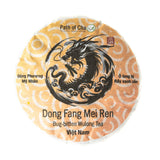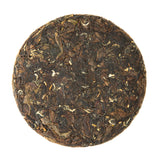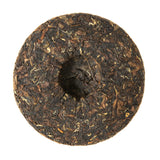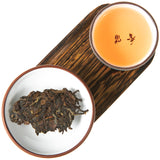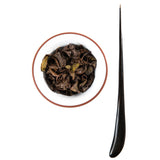— Sifu, this is such a beautiful tea. Black, brown, white, yellow, and green... the colors remind me of the autumn leaves!
Lao Cha answers — This tea represents the cycles of nature. Every summer, the leafhoppers come to feast on these nutritious tea leaves. Thanks to the natural defense system of the bushes, they provide us with an even sweeter, more vibrant tea than before. The tea leaves, harvested in the summer, are ready for us to enjoy when autumn comes around. Enjoy the honey-like taste and be grateful for the forces that provide us with this exceptional tea.
This Oriental Beauty Oolong – a traditional Taiwanese tea – is a unique representative of its kind. It comes from a beautiful valley in the Hoàng Liên Sơn mountain range in Vietnam. The producer is following quintessentially Taiwanese oolong processing techniques and then pressing it into tea cakes, just like pu-erh!
The tea gardens, where the bushes grow, are kept natural, without pesticides. Each year, bugs known as leafhoppers come to feast on the tea leaves. To attract birds and to scare off the leafhoppers, the leaves produce terpenes with a honey aroma. It alters the final taste of the tea wonderfully, creating a honey-like flavor and turning the tea tips white. – This tea processing technique is adopted from Taiwan and is known as "bug-bitten tea". In this sense, Dongfan Meiren is a classic representative of a bug-bitten oolong.
After harvest, the tea undergoes heavy oxidation. The taste is bright and well-balanced, with notes of fruits and flowers, and its lingering sweet finish gently coats the palate. The tea leaves are baked in layers, with hot air rising from the bottom up. The first roast requires a temperature of around 90ºC for about 30 min, leaving the tea leaves half-dry. Then, the leaves are left to rest, allowing the remaining moisture in the stems to spread evenly to the leaves. Then comes the final baking, done at around 80ºC for about 3 hours, to fully dry the tea leaves. The result is heavily oxidized oolong tea with oxidation levels between 60% and 85%. The relatively cool temperature preserves tea's natural aroma.
Our Oriental Beauty oozes a charming natural fragrance. The tea soup is clear with a bright color. The aroma carries honey and ripe fruit notes. When the tea soup enters the throat, it is sweet and mellow.
Dong Fang Mei Ren Oolong Tea is rich in amino acids, giving the tea soup a sweet taste. Due to heavy oxidation, more than half of the catechins oxidize, reducing bitterness and astringency. As a high-quality representative of this tea type, it has a pronounced ripe fruit aroma and a honey-like taste. A distinctive sweet aftertaste blooms in the mouth and lingers on the tongue and cheeks.
Brewing guidelines:
![]() 205℉ / 95℃
205℉ / 95℃
 1g per 70-100ml
1g per 70-100ml ![]() 3-5min
3-5min
 1g per 20ml
1g per 20ml ![]() 10sec + 5sec for each subsequent infusion
10sec + 5sec for each subsequent infusion





